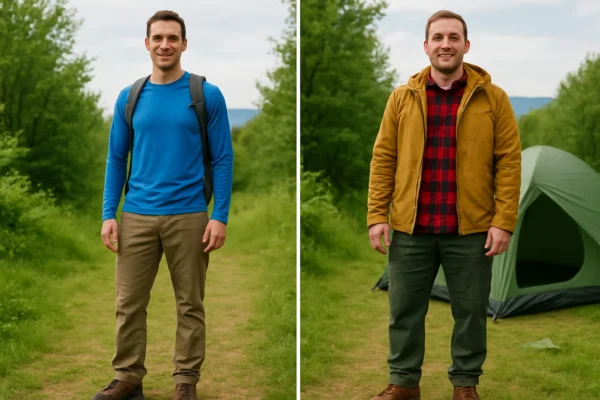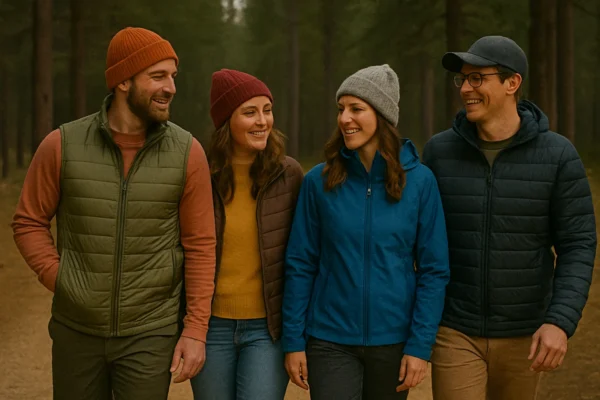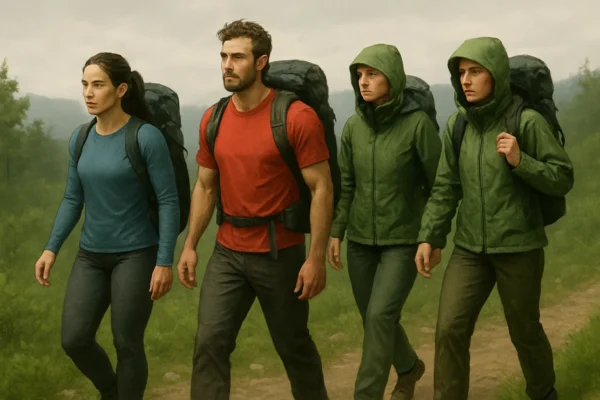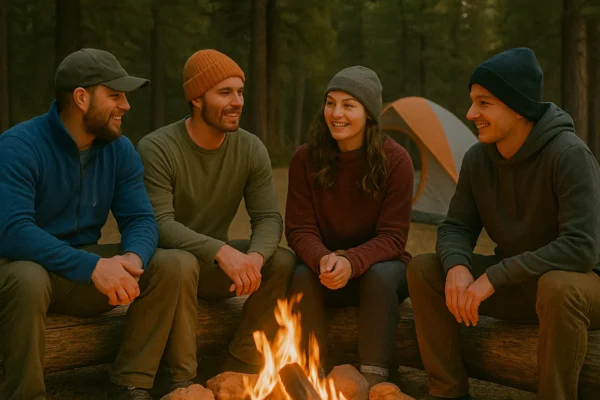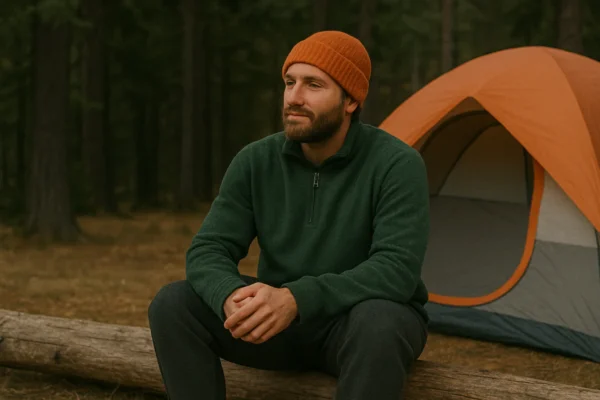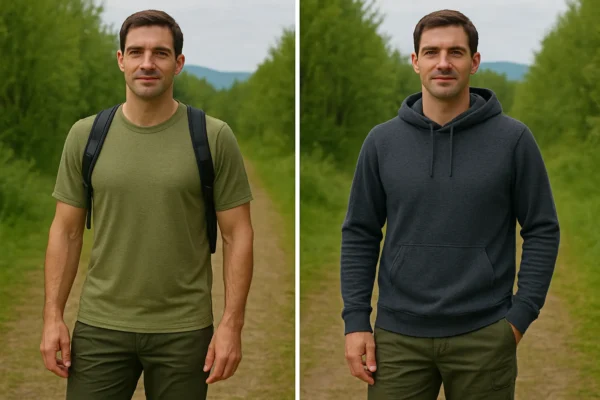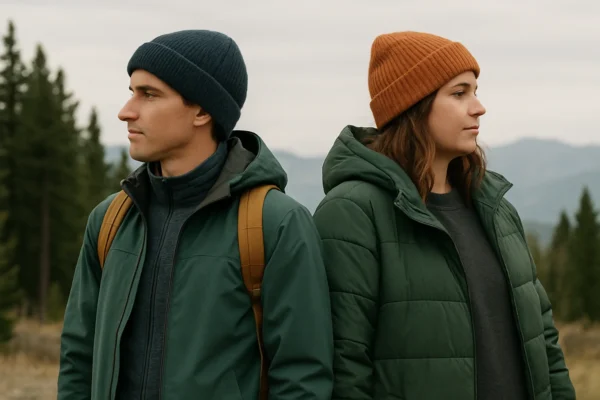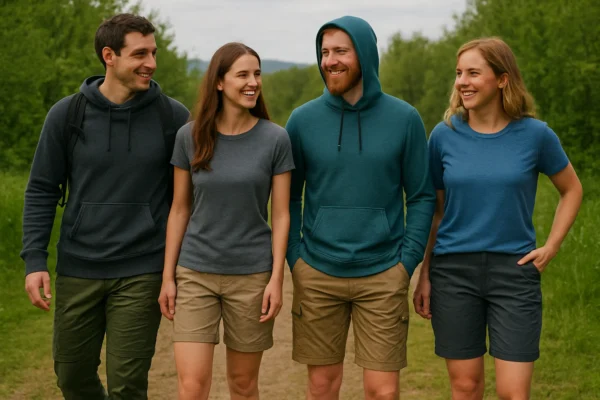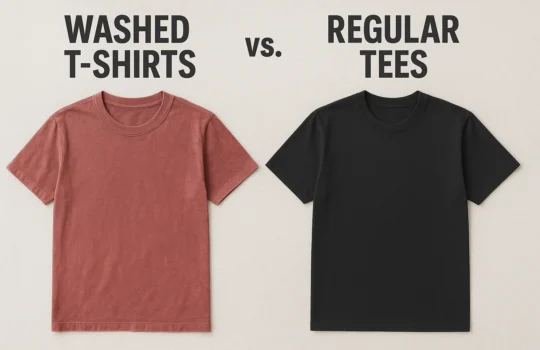Hiking vs. Camping Clothing: Key Differences & Smart Packing Tip
When it comes to outdoor adventures, camping and hiking often go hand in hand but that doesn’t mean you should dress the same for both. While both activities take place in nature and expose you to changing weather, their demands on clothing are actually quite different. Hiking involves constant movement, elevation changes, and sweat, which means your gear needs to prioritize breathability, mobility, and moisture management. On the other hand, camping is usually more stationary, where comfort, warmth, and smart layering for varied conditions become the priority.
Understanding these differences is key to packing the right clothing for your trip. In this guide, we’ll break down what to wear for both activities and why one piece of clothing might be perfect for camp but not ideal on the trail.
Camping vs. Hiking Clothes: What’s the Real Difference?
Although both camping and hiking take place outdoors, they place very different demands on your clothing. What works well on a steep trail might leave you shivering at a windy campsite—and vice versa. To dress smartly for either activity, it’s essential to understand how movement, comfort, and temperature management affect your gear choices.
Activity Level & Purpose
Hiking is high-output, often involving elevation gains, long distances, and unpredictable terrain. Because of that, hiking clothes are built to support movement and regulate body temperature. Think moisture-wicking base layers, breathable mid-layers, and abrasion-resistant fabrics that can handle brush and pack straps. Everything is about balancing performance and weight.
In contrast, camping is slower-paced. You spend more time around the tent, cooking, resting, or stargazing. Here, the focus shifts to comfort and warmth, clothes that feel good after sunset, offer versatile layering, and can double as sleepwear or loungewear. A cozy sweatshirt or soft fleece may not hike well, but it’s perfect for sipping coffee by the fire.
Fabric & Comfort
One rule applies to both activities: avoid cotton. It absorbs moisture, dries slowly, and holds onto cold, a recipe for discomfort and even hypothermia in cool conditions. That’s why many experienced campers and hikers warn against cotton, it holds moisture and can leave you cold fast.
For hiking, you’ll want fabrics like synthetic blends or merino wool, which are lightweight, quick-drying, odor-resistant, and breathable. These materials reduce bulk and stay comfortable when you’re sweaty or active.
For camping, the equation is a little different. Since you’re not generating as much body heat, it’s okay to wear heavier fleece or plush sweatshirts that feel warm and soft. Breathability still matters, but you can prioritize cozy textures and durable fabrics over ultralight performance gear.
Layering Strategy
Hiking usually sticks to the classic three-layer system:
- Base layer: pulls sweat away from the skin
- Mid-layer: traps heat (like a performance fleece or grid hoodie)
- Shell layer: blocks wind, rain, or snow
This system is all about flexibility and thermoregulation during physical exertion and changing trail conditions.
Camping, on the other hand, allows for more relaxed and adaptive layering. You might still use a base layer, but your mid-layer could be a loose-fitting sweatshirt or fleece jacket, and your outerwear might include a puffy coat, a poncho, or even a blanket hoodie. At night, many campers sleep in these layers, so comfort becomes part of the equation.
Hiking or Camping? Dress for the Right Part of the Journey
Packing for the outdoors can be tricky, especially when your trip includes both active hiking and relaxed camping time. While some clothing can do double duty, understanding the difference between what’s best for movement versus rest helps you stay dry, warm, and comfortable throughout your trip. Let’s break down when to prioritize hiking gear, when to pack cozy camp clothes, and which versatile pieces can handle both.
For Day Hikes or Multi-Day Treks
When you’re on the move—whether it’s a short day hike or a multi-day trek—hiking-specific clothing is essential. You’ll want to wear:
- Base layers that pull moisture away from your skin to help you stay dry while moving
- Fast-drying shirts made from synthetic fabrics like polyester or nylon, designed to handle sweat and light rain efficiently
- Stretchy hiking pants that allow full range of motion
- Breathable rain shells to manage wind and wet conditions
- Lightweight socks made of synthetic or merino wool to prevent blisters and wick moisture
This type of gear is built for performance and efficiency, helping you stay cool and dry during exertion while also being durable enough to handle trail abrasion.
For Camp Comfort or Evening Wear
Once you’re done hiking for the day and settling into camp, comfort becomes the top priority. This is when you’ll appreciate having dedicated camping clothes: something warm, dry, and soft after a long day.
Pack items like:
- A fleece pullover or warm hoodie for insulation
- Merino wool lounge pants or relaxed synthetic joggers
- A clean, dry synthetic or merino tee that doubles as sleepwear
- Optional extras like wool socks or down booties for chilly evenings
These aren’t designed for miles of hiking—but they make a huge difference when you’re sitting around a campfire, cooking dinner, or winding down in your tent.
Overlap & Versatile Pieces
While some clothing is best reserved for either hiking or camping, there are a few hybrid pieces that work well for both. These items offer enough performance features for the trail, but are comfortable and low-key enough to wear at camp too.
Examples include:
- Quick-dry synthetic T-shirts that layer well and stay fresh
- Merino wool hoodies that insulate, breathe, and resist odor
- Stretchy zip-off hiking pants that can double as shorts during the day and still feel relaxed enough around the tent
If you’re packing light or thru-hiking, investing in these multi-use layers can save weight while still keeping you prepared for changing conditions.
How to Pack Smart for Camping and Hiking
When it comes to packing for a camping trip that may include hiking, efficiency matters, both in terms of space and function. The goal is to stay comfortable across different activity levels and weather conditions without overstuffing your backpack. Smart clothing choices can reduce bulk while keeping you well-prepared from trail to tent.
Choose Versatile, Multi-Use Items
Instead of packing separate outfits for every scenario, focus on pieces that perform double duty.
For example, a moisture-wicking base layer tee can be worn while hiking and then layered under a hoodie at camp. A merino wool hoodie works well as a mid-layer on the trail and also feels cozy around the fire at night.
Likewise, synthetic or wool socks dry quickly, manage moisture, and stay warm even when damp, ideal for both hiking boots and camp shoes.
Limit Redundancy in Your Clothing System
While it’s tempting to bring a fresh set of clothes for hiking and another for lounging, you’ll quickly run out of room. Instead, plan a flexible layering system where each item has a purpose across different settings.
Your hiking pants can double as campwear. A breathable long sleeve shirt can serve as both sun protection on the trail and warmth at night. Avoid packing multiples unless truly necessary (like underwear or socks).
Don’t Skip the Shell Layer
Even if you’re expecting mild conditions or don’t plan on hiking far, a waterproof and windproof shell layer is essential.
Weather can change fast in the outdoors, and having a lightweight shell jacket gives you a protective barrier against wind, rain, or sudden temperature drops, whether you’re climbing a ridge or relaxing by the campfire. It’s one of the most important pieces you can bring, no matter how short or static your trip seems.
3 Common Layering Errors (and How to Fix Them)
Whether you’re new to the outdoors or a seasoned camper, it’s easy to make clothing choices that seem fine in theory but fail in practice. The wrong materials or misjudging your layering system can turn a great trip into a frustrating (and cold) one. Let’s break down a few common mistakes people make and how to avoid them.
Thinking Cotton Is “Good Enough”
It might feel soft and breathable at home, but cotton is a poor choice in outdoor environments. Once wet—whether from sweat, rain, or dew—cotton holds onto moisture and loses its ability to insulate. That damp fabric sits against your skin, pulling heat away and increasing the risk of chilling or even hypothermia.
No matter if you’re on the trail or winding down at camp, steer clear of cotton and stick with wool or synthetic layers that handle moisture far better.
Packing Fashion Over Function
It’s tempting to throw in your favorite hoodie or stylish sweatpants, but fashion-focused clothing rarely performs well outdoors. These items often lack moisture-wicking, breathability, and insulation when it matters most.
Instead, prioritize technical fabrics designed for the outdoors, gear that dries fast, moves with you, and maintains warmth even when damp. You’ll stay better prepared and feel more at ease when the weather or activity level changes.
Mismatching Layers to the Activity
One of the most common missteps is not adjusting your layers based on what you’re doing. For example, wearing your thick camp fleece on a steep hike might feel cozy at first, but you’ll quickly overheat and sweat through it. That sweat gets trapped in your insulating layers and compromises warmth later.
Similarly, trying to sleep in the damp clothes you hiked in is a recipe for a cold, restless night. Plan to change into dry, appropriate layers for each part of your day and your body will thank you.
Wrap-Up: Outdoor Apparel That Works Harder
Choosing the right clothes for your outdoor adventure isn’t just about style—it’s about function, comfort, and safety.
For hiking, focus on clothing that helps you move freely, stay dry, and handle variable trail conditions. Think moisture-wicking layers, durable fabrics, and gear that breathes when you’re on the go. Once you’re at camp, your priorities shift: warmth, comfort, and versatility become key. That’s when warm fleece, a light hoodie, or soft wool layers really prove their worth, ideal for winding down, staying warm at night, or taking care of camp tasks.
The best approach? Pack smart, not heavy. Choose pieces that can do double duty across both environments. Build a flexible layering system that lets you adapt easily, whether you’re climbing a trail or sipping tea under the stars. A little planning makes a big difference when it comes to staying dry, warm, and happy outdoors.


